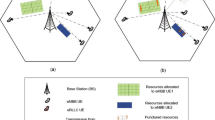Abstract
In a wireless packet (ATM) network that supports an integrated mix of multimedia traffic, the channel access protocol needs to be designed such that mobiles share the limited communications bandwidth in an efficient manner: maximizing the utilization of the frequency spectrum and minimizing the delay experienced by mobiles. In this paper, we propose and study an efficient demand-assignment channel access protocol, which we call Distributed-Queueing Request Update Multiple Access (DQRUMA). The protocol can be used for a wide range of applications and geographic distances. Mobiles need to send requests to the base station only for packets that arrive to an empty buffer. For packets that arrive to a non-empty buffer, transmission requests are placed collision-free by piggybacking the requests with packet transmissions. The simulation results show that even with the “worst possible” traffic characteristics, the delay-throughput performance of DQRUMA is close to the best possible with any access protocol. In addition, explicit slot-by-slot announcement of the “transmit permissions” gives the base station complete control over the order in which mobiles transmit their packets. This important feature helps the base station satisfy diverse Quality-of-Service (QoS) requirements in a wireless ATM network.
Similar content being viewed by others
References
N. Abramson, The ALOHA system — Another alternative for computer communications,AFIPS Conf. Proc., 1970 Fall Joint Computer Conf., 37, pp. 281–285.
L. Kleinrock and S.S. Lam, Packet switching in a multiaccess broadcast channel: Performance evaluation, IEEE Trans. Commun. COM-23 (1975) 410–423.
J.I. Capetanakis, Tree algorithms for packet broadcast channels, IEEE Trans. Inform. Theory IT-25 (1979) 505–515.
B.S. Tsybakov and V.A. Mikhailov, Slotted multiaccess packet broadcasting feedback channel. Prob. Peredachi Inform. 14 (1977) 32–59
J.L. Massey, Some new approaches to random-access communications,Performance '87 (1988) pp. 551–569.
R. Rom and M. Side,Multiple Access Protocols: Performance and Analysis (Springer, 1990).
P. Pancha and M. Karol, Guaranteeing bandwidth and minimizing delay in packet-switched (ATM) networks,Proc. CISS'95 (1995).
N. Amitay, Resource Auction Multiple Access (RAMA): Efficient method for fast resource assignment in decentralized wireless PCS, Electron. Lett. 28 (1992) 799–801.
N. Amitay. Distributed switching and control with fast resource assignment/handoff for personal communications systems, IEEE J. Select. Areas Commun. SAC-11 (1993) 842–849.
D.J. Goodman, R.A. Valcnzucla, K.T. Gayliard and B. Ramamurthi, Packet reservation multiple access for local wireless communications, IEEE Trans. Commun.COM-37 (1989) 885–890.
K.Y. Eng et al., BAHAMA: A broadband ad-hoc wireless ATM local area network,Proc. ICC'95 (1995) pp. 1216–1223.
C. Woodworth, M.J. Karol, Z.J. Haas and R.D. Gitlin, Speetrally efficient universal time slots using time-frequency-code slicing,Proc. ICCCWCN (1994) pp. 1009–1013.
Author information
Authors and Affiliations
Rights and permissions
About this article
Cite this article
Karol, M.J., Liu, Z. & Eng, K.Y. An efficient demand-assignment multiple access protocol for wireless packet (ATM) networks. Wireless Netw 1, 267–279 (1995). https://doi.org/10.1007/BF01200846
Issue Date:
DOI: https://doi.org/10.1007/BF01200846




